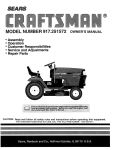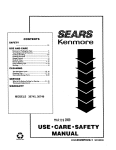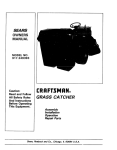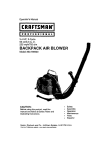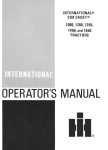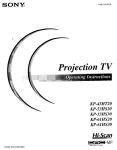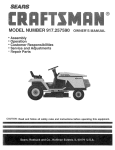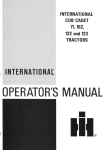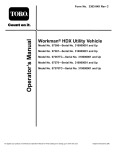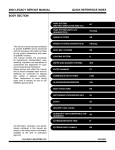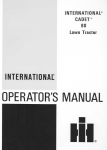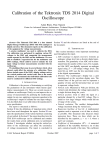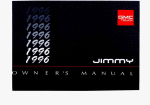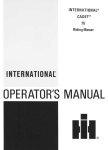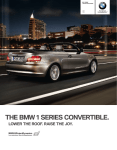Download Crown Boiler 24-07 Boiler User Manual
Transcript
have difficulties with the unit consult your Assembled in this manual are operation, lubriInternational Harvester dealer. UNDER NO CIRcation, and maintenance instructions for the CUMSTANCES SHOULD YOU ATTEMPTTO International Cub Cadet 86, 108, 128, 129, 149, SERVICE THESE UNITS YOURSELF. Only your and 169 Tractors. The material has been prepared dealer is authorized to repair or replace units on in detail to help you better understand the correct this drive under the terms of the warranty. Should care and efficient operation of your tractor. Before you operate the tractor, study this manual care-fully.you desire additional information not found in this manual, contact your International Harvester New copies may be ordered from your dealer dealer. at a nominal price. Your local I nternational Harvester dealer is interested in the performance you receive from this tractor. He has factory-trained servicemen, informed in the latest method of servicing tractors, modern tools, and original-equ ipment I H service parts which assure proper fit and good performance. The International Cub Cadet 129, 149, and 169 Tractors have a hydrostatic drive. It is the best hydraulic drive unit available and will require minimum service if recommended operation and maintenance procedures are followed. Should you The I nternational Tractors mission. Cub Cadet have a conventional 86, 108, ... and 128 clutch ana trans- To obtain top performance and assure economical operation the tractor should be inspected, depending on its use, periodically, or at least once a year, by your International Harvester dealer. When in need of parts, always specify the model, chassis, and engine serial numbers, including the prefix and suffix letters. Write these serial numbers in the space provided on page 4. MODEL DELIVERY DATE Serial No. 500718 and above. A variety of extra equipment and accessories isavailable. LEFT and RIGHT indicate of the tractor when facing Where operating and maintaining instruction is required, it is included in the instruction for seat. Reference to F RaNT of the tractor; to REAR the operating and maintaining the tractor. Disregard the instructions for equipment not on your tractor. the left and right sides forward in the driver's indicates the grille end drawbar end. This manual is for tractors with Serial No. 507 000 and above. 4 This symbol is used to call your attention to instructions concerning your personal safety. Be sure to observe and following these instructions. Disengage power to any attachments and stop engine before leaving operator's seat or making any repairs or adjustments. Use care when pulling loads or using heavy equipment: -A. Use only approved hitch points. B. limit loads to those you can safety control. C. Don't turn too sharp, and use care when backing. D. Use counterweight or wheel weights when suggested in Operator's Manual. Know the controls and how to stop quickly READ THE OPERATOR'S MANUAL. Watch out roadways. Disengage all clutches and shift into neutral before starting the engine. - for traffic when crossing or near When using any attachments, never direct discharge of material toward bystanders nor allow anyone near the machine while in operation. Do not allow children or adults to operate the equ ipment without proper instruction. Clear work area of objects which might be picked up and thrown. Handle gasoline with care -it is highly flammable: -A. Use approved gasoline container. B. Never remove the fuel tank cap or fill the fuel tank when the engine is running, is hot, or indoors. Also, do not smoke when working around inflammable fuel. Wipe up spilled gasoline. C. Replace gasoline cap securely. D. Open doors if engine is running in a garage -exhaust gasesare dangerous. Disengage power to any attachment when transporting or not in use. Do not carry passengers of give rides. Keep children, pets, and by-standers a safe distance away. Always disengage the power take-off, shift transmission into neutral, set the parking brake, stop the engine, and remove ignition key when leaving the machine unattended. Keep machine in good operating condition and keep safety devices in place. Use guards or shields as instructed in Operator's Manual. Reduce speed on slopes and in sharp turns to prevent tipping or loss of control. It is recommended that the machine be stopped and inspected for damage after striking a foreign object and that any damage be repaired before restarting and operating the machine. Stay alert for holes in terrain and other hidden hazards. Always depress the brake pedal and set the brake Don't stop or start suddenly when going uphill ordownhill. pedal lock before working on the machine. Disengage all implements and shift the transmission into neutral. 5 Your Cub Cadet Tractor has been safety engineered. Thoroughly acquaint yourself with all the instruments and controls before attempting to start or operate the tractor. Instruments and controls on the International Cub Cadet 86, 108, and 128 Tractors. 10. 11. 12. 2.4. 3. 5. 6. 7. 8.1. 9. Choke Brake Clutch-brake Creeper Throttle Gearshiftlever Charge Lighting Front Electricliftcontrolswitch* Lift Ignition handle pedal power control indicator shift switch switch camlock take-off pedal lever* button. button* stop """"""""""""""""'-:":'--"""" clutch See page 12 See page 9 See pages 12 and 13 See page 13 See page 18 See page 13 See page 15 lever. Seepage 21 Seepage 8 Seepage 18 and 19 Seepage22 * Optional Equipment 6 Instruments and controls on the International Cub Cadet 129, 149, and 169 Tractors. 10. 11. 12. 3.9. 4. 7. 8. 2. 1. 5. 6. Speed Choke Charge Throttle Brake Hydraulic Release Lighting Ignition Hour Front Lifthandlecamstop Electrict meter- pedal. power pedal control control indicator lever.switch. 13. lever switch lift* lift lock take-off(Standard control (Not lever button button* shown.) clutch handle on (Standard : Model Available lever 169 on on Models only) all but 149 the and 169) Seepage 14 Seepage 14 Seepage 14 Seepage 9 Seepage 18 Seepage22 Seepage20 Seepage 8 Seepage21 See page 15 See page 15 See page 22 Model 149 and 169 Tractors. * Optional Equipment 7 4. Lubrication Lubricate the entire tractor. See pages 33 to 41 Tires. Check the air pressure. See pages 24 to 26 Fuel System. Fill the fuel tank with gasoline. See pages 10 and 11. Fuel line 5. Fuel shut-off valve 6. Air cleaner 1. Fuel tank filler cap 2. Fuel tank 3. Carburetor (not seen) Fuel System. THROTTLE LEVER This lever controls the speed of the engine. When set in a given position, it will maintain a uniform engine speed. When using power take-off operated equipment, best performance is achieved with the throttle lever in the "FAST" position. GOVERNOR The governor is set at the time the engine is assembled and should not require readjustment unless the governor arm is removed or loosened from the governor shaft. Consult your I nternational Harvester dealer if the governor does not function properly. 8 3. 4. 5. 1. 2. OPERATINGTHE ENGINE LIFTING THE HOOD Pull the choke control button all the way out. More or less choking may be necessary due to variations in temperature, grade of fuel, etc. Little or no choking will be needed when the engine iswarm. The tractor hood is arranged to swing up and forward to make the engine and fuel tank readily accessible. To raise the hood take hold of the spring latches on each side of the pedestal and lift up and out to release the spring latches from the hood crossmember. Place the throttle "SLOW" and "FAST", lever half-way between Place the throttle "SLOW" and "FAST". lever half-way between 6. To start the engine the clutch-brake pedal must be pressed all the way down and the power take-off clutch handle must be in the disengaged position to actuate the safety starting switches. On the I nternational Cub Cadet 129, 149, and 169 Tractors the speed control lever will return to neutral wher the clutch-brake pedal is pressed all the way down. International Cub Cadet 86, 108, and 128 Tractors: Check to see that the gearshift lever is in the neutral position. All Models: Turn the ignition key clockwise to the "ST ART" position and release it as soon as the engine starts; however do not operate the motor generator for more than 30 seconds at anyone time. If the engine does not start within this time, turn the key "OFF" and wait a few minutes, then try again. Be sure there is an adequate supply of gasoline in the fuel tank. 5. After the engine starts, slowly release the clutch-brake pedal and gradually push the choke control button all the way in. Do not use the choke to enrich the fuel mixture, except when necessary to start the engine. A STOPPING THE ENGINE STARTING THE ENGINE CAUTION! Never remove the fuel tank cap or fill the fuel tank when the engine is running, is hot, or indoors. Also, do not smoke when working around inflammable fuel. Move the throttle lever to the "SLOW" position and allow the engine to idle for a short time before stopping. Then turn the key to the "OFF" position. Be sure the fuel shut-off valve is open. 9 The ~ FUEL SYSTEM This engine is designed to operate on leaded gasoline with a 93 minimum octane rating or on unleaded or low lead gasoline with a 91 minimum octane rating (Research Method). use of unleaded gasoline will lengthen spark plug and valve life, maintain engine performance longer, and reduce rust and corrosion of engine wh ile stored. The fuel tank filler cap has an air vent. Keep the vent open at all times to assure proper flow of thefuel. A CAUTION! Never remove the fuel tank cap or fill the fuel tank when the engine is running, hot, or when near an open flame. Do not smoke when working around inflammable fuel, as the air around the tractor is mixed with a highly explosive vapor. When pouring fuel, keep the container or hose nozzle in contact with the metal of the fuel tank to avoid the possibility of an electric spark igniting the gas. Do not spill gasoline on a hot engine. International Cub Cadet 86 Tractor. FUEL SHUT-OFF VALVE Be sure the shut-off valve under the fuel tank isopen. Screw out the needle stem (shut-off valve) until the seat on the stem is tight against the stop to prevent leakage or seepage when the valve is in its full-open position. CARBURETOR 1. Governor control rod2. Idle adjustment screw3. Throttle stop screw4. High speed adjustment screw5. Fuel shut-off valve6. Fuel line7. Air cleaner ADJUSTMENTS The carburetor is adjusted at the factory and under normal operation conditions it will not require readjusting. However, if the engine does not operate properly, it is recommended a new air cleaner be installed before performing carburetor adjustments. If this adjustment has been disturbed for any reason, proceed as follows: 10 International Cub Cadet 108, 128, 129, 149, and 169 Tractors. 11 FUEL SYSTEM CARBURETOR ADJUSTMENTS -Continued A CAUTION! Be sure the brake pedal is in the locked position, transmission is in neutral, and the mower is disenga~d before adjusting the carburetor. If the engine shows a sooty exhaust and is sluggish under load, the high speed mixture is too rich. The high speed adjustment screw must be turned clockwise 1/4 turn at a time until the condition is corrected. Adjusting the Idle Adjustment Screw Adjusting the High-SpeedAdjustment Screw Turn the high speed adjustment screw counterclockwise approximately two turns from the closed position and start the engine. Be sure the choke is fully open when adjusting. After the engine has reached normal operating temperature, place the throttle lever in the fast position and turn the high speed adjustment screw clockwise to the leanest mixture that will allow sat i sf actory acceleration and steady governor operation. Then, turn counterclockwise to the richest mixture that allows satisfactory operation. The difference between the rich and lean points is about 1/2 turn. Set the mixture to the rich end of this range. After the high speed adjustment screw is adjusted, it may be necessary to readjust the idle adjustment screw as each affects the other. Close the idle adjustment screw to its seat by turning it clockwise; then open it one turn. Start the engine and operate it at fast idling speed (without any load) until thoroughly warm. While the engine is running at fast idle speed, it is advisable to screw in the throttle stop screw a few turns to keep the engine from stopping when the throttle lever is moved to the fully retarded "SLOW" position. The engine will then be idling at a fairly high speed and the throttle stop screw can be backed out a little at a time until the desired idle speed is obtained. If the engine misses and backfires under load, the high speed mixture is too lean. The high speed adjustment screw must be turned counter-clockwise 1/4 turn at a time until the condition is corrected. PREPARING THE TRACTOR If the engine misses or rolls while backing out the throttle stop screw, the idle adjustment screw may be adjusted in or out until the engine operates smoothly. Speed up the engine for a few seconds; then recheck the idle adjustment. A slight adjustment in or out will give the smoothest idle. FOR EACH DAY'S WORK Check the crankcase oil level and add new oil if necessary. See pages 34 and 35. Clean the air cleaner element if necessary. See page 21. Inspect the tires for general condition. See page 26 Retighten the cap screws after the seat is adjusted. NOTE: The battery is located in a well under the operator's seat for ease in servicing or replacement when necessary. CLUTCH AND BRAKE PEDAL Brake pedal lock in the engaged position. Adjusting the seat. LOCKING THE BRAKE Always lock the brake when the tractor is parked on a grade. To lock the brake, press down on the pedal; then place the brake pedal lock in the engaged position. To disengage the lock, press down on the pedal, lift the lock up and place it in the disengaged position. Before starting the tractor, adjust the seat to the most comfortable driving position. Tile the seat forward over the steering wheel, loosen the four cap screws in the seat support, and slide the seat assembly forward or rearward to the position wh ich is most comfortable for the operator. 12 InternationalCub Cadet86, 108 and 128 Tractors CLUTCH-BRAKE free the tractor by speeding up the engine and suddenly engaging the clutch. Try backing out instead of going forward. PEDAL The combination clutch-brake pedal is used to disengage the engine from the transmission when shifting gears and to actuate the brake to stop the tractor. The pedal must be pressed all the way down to activate the safety starting switch when starting the engine. Do not carry passengersor give rides. Keep children, pets, and bystandersa safedistance away. STOPPING THE TRACTOR To disengage the clutch, and apply the brake, press the pedal all the way down. GEARSHIFT Disengage the clutch by pressing the pedal all the way down. Move the gearshift lever to the "N" position. Before dismounting always lock the pedal, disengage the power take-off, and turn the ignition "OFF". LEVER lever is used to select various gear ratios provided in the transmission. There are threeforward speeds and one reverse speed. Refer to "SPECIFICATIONS" CREEPER Advance the throttle lever slightly. Disengage the clutch by pressing the clutch pedal all the way down, and release the brake lock. Move the gearshift lever to the desired speed. OPERATING Start the tractor in motion by slowly releasing the clutch pedal and moving the throttle lever to the position where the engine operates best for the load to be handled. THE CREEPER DRIVE To operate the tractor in creeper drive, depress the pedal and move the creeper shift lever all the wayrearwar Then select the transmission speed desired and proceed as instructed under "Starting the Tractor". NOTE: When using power take-off operated equipment, best performance is achieved with the throttle lever in the "Fast" position. NOTE: Do not use a mid-point position on the creeper drive as neutral. Neutral position must be selected only with the standard transmission gearshift lever. NOTE: Do not shift gears while the engine clutch is engaged or while the tractor is in motion. The following table shows the speeds available in each of the three forward gears and the reversegear. NOTE: Do not rest your foot on the pedal while driving the tractor, as this will result in excessive clutch lining wear. Always be sure the rear wheels are free to turn. Under any adverse conditions, do not attempt to CAUTION! This 2. 3. LEVER The creeper drive (optional) provides a slower speed in each respective gear, by a four-to-one reduction in speed from direct drive. When the creeper shift lever is all the way forward, it is in direct drive, or all the way rearward, it is in creeperdrive. STARTING THE TRACTOR 1, SHIFT on page 42. 13 1.7 2.5 2. 3. 4. DRIVING THE TRACTDR International Cadet 86, 108 and 128 Tractors OPERATING THE CREEPER DRIVE SPEED TABLE Miles Per Hour Gear Creeper Direct Drive Drive Second 2.3 .6 3.5 1.0 6.8 .6 Reverse International Cub Cadet 129, 149, and 169 Tractors BRAKE PEDAL The brake pedal must be pressed all the way down to activate the safety starting switch. When the brake pedal is in the depressed position it automatically moves the speed control lever to the "N" position. NOTE: On tractors with a rotary tiller the following instructions are required. 1. Engage the Power Take-Off clutch, and move the throttle to "Fast". The tractor can be stopped either by pressing the pedal all the way down, or placing the speed control lever in the "N" position. Lower the rotary tiller to the desired cutting depth. Move the speed control lever motion. NOTE: In rotary tilling tractor is used to hold the rotary than to pull the unit as in plowing SPEED CONTROL LEVER This lever is used to select any speed from a standstill "N" position to eight miles per hour in the forward direction and to four miles per hour in the reverse direction. to start forward application, the tiller back rather or mowing. Move the speed control lever back to a position to maintain proper mulching of the soil. Moving the speed control lever forward provides increased forward speed, and moving the lever rearward provides the reversespeeds. 5. With a hydrostatic drive, it may vary the speed control lever as the With a gear driven tractor, conditions it may be necessary to use the brake. NOTE: Do not rest your foot on the brake pedal while driving the tractor as this would cause the speed control lever to return to the "N" position. 14 be necessary to soil conditionsvary. under similar declutch or to DRIVING THE TRACTOR International Cub Cadet 129, 149, and 169 Tractors CAUTION! Never operate engine with release lever in (up) position. Towing or pushing the tractor for more than a few 1. Depress the brake pedal and release the brakelock. feet may result in transmission damage. Move the throttle lever to the position wherethe engine operates best for the load to be handled. STOPPING THE TRACTOR 2. Start the tractor in motion by moving the speed Move the speed control lever to the "N" position control lever slowly forward or rearward as deor use the brake. Before dismounting always lock scribed above. the brake pedal and turn the ignition "OF F", Also, disengage the power take-off clutch lever. RELEASE LEVER STARTING THE TRACTOR To push or move the tractor for a short distance,the release lever must be held in the (up) positionand the speed control lever must be in the "N" position. The lift handle is used to lift or lower equipment used with the tractor. The equipment can be set in multiple positions by depressing the button on the top of the handle and releasing it when the desired position is reached. Do not carry passengers or give rides. Keep children, pets, and bystanders a safe distance away. If free handle travel between cam stop and fully raised position is desired (Float Position), depress the release button on top of the handle, press in the lock button located at the front of the handle and release the top button. HEIGHT ADJUSTMENT If a single implement height is normally used, the handle may be adjusted to locate the desired position by use of the cam stop. NOTE: To disengage the lift handle from the float position, pull lift handle back slightly and depress With lift handle in desired implement height positop button. tion, release cam by turning locking knob counter-clockwise. Turn cam until it contacts tang. Lock NOTE: Refer to the equipment manual for proper cam into this position by turning knob clockwise. hitching instructions. CAUTION! 15 1. Lift lever 2. Draw bar 3. Three-point hitch Orawbar and three-point hitch shown on International Cub Cadet 86 Tractor. DRAWBAR 4. Cam lock knob 5. Cam stop 6. Tang 1. Release button2. Lock button3. Lift handle Orawbar equipment must be hitched to the tractor only at the hitch hole in the drawbar. Adjustable stop limiting handle travel. THREE-POINT HITCH When the tractor has a three-point hitch, equipment adaptable to this hitch is raised and lowered with the lift handle or power lift control. The lift handle can be set to hold the equipment at various positions by use of the notches in the lift handle quadrant or cam stop. The lower mounting bracket has three holes which are used for additional A CAUTION! attachment Disengage when power transporting to or any not in use. NOTE: Refer to the equipment manual for proper hitching instructions. adjustment. 16 3. InternationalCub Cadet86, 108and 128 Tractors 1. Shifter lever OPERATING THE REAR POWER TAKE-OFF WITH THE TRACTOR STANDING STILL 1. Move the throttle lever back to the "SLOW" speed. 2. Depress the pedal and move the transmission gearshift lever to the neutral position. 1. Power take-off guard 2. Greasefitting Move the shifter position. lever forward to the engaged If your tractor is equipped with a rear power take-off, the following instructions should be carefully studied and followed. 4. Move the throttle lever forward to the "FAST" position and slowly release the pedal. The rear power take-off is started and stopped by the same engine clutch as the tractor. Be sure to disengage the engine clutch before moving the power take-off shifter lever. OPERATING THE REAR POWER TAKE-OFF WITH TRACTOR IN MOTION A CAUTION! be in The the shifter disengaged lever should (rearward) Follow steps 1 thru 3 outlined above. Keep the pedal depressed, move the transmission gearshift lever to the speed desired and advance the throttle lever. Slowly release the clutch pedal. This will start the tractor in motion with the power take-off in operation. always position when the power take-off is not in use. Always cover the power take-off exposed shaft with the guard when the power take-off is not being used. 17 3. OPERATING THE FRONT POWER TAKE-OFF CLUTCH t. Move the throttle "slow" position. 2. Move the control engaged position. lever back to the medium or lever forward slowly to the Advance throttle to operating speed. ADJUSTING THE POWER TAKE-OFF CLUTCH 1. Clutch lever bracket 2. Quick attachable cotter pin 3. Clutch lever rod 4. Clutch control handle 5. Turnbuckle The clutch is factory adjusted require further adjustment under conditions. However, if clutch disengage, see your International With the clutch fully engaged (clutch control handle in the forward position) the clearance between "A" and "B" should be minimal. When disengaged, the plate "B" (with three legs) should move a minimum of 1/10 inch to insure disengagement. To adjust for proper clearance, loosen the jam nut on the clutch lever turnbuckle, and adjust the turnbuckle. After obtaining the proper clearance tighten the jam nut securely against the turnbuckle. and should not normal operating slips or fails to Harvester dealer. After considerable use, it may be necessaryto readjust the clutch to secure proper clutch engagement. A CAU!'ON! Do not adjust with NOTE: Periodically lubricate the bushing in the clutch lever bracket with a few drops of engine oil. engine running. The electric lift is a self-contained unit designed to provide power with fingertip control for raising the lowering mounted equipment. The electric lift is available on all Cub Cadet Tractors except the Models 149 and 169 wh ich is equipped with a hydraulic lift as standard. 18 ELECTRIC LIFT OPERATING INSTRUCTIONS 1. Locking knob2. Cam stop3. Rockshaft arm described on page 15 to allow implement to return to a single preset hei~ht. 1. Float lockout pin (optional)2. Electric lift unit 3. Pivot pin To operate equipment in a fixed "locked" position, where down pressure of implement is required (that is blade work); remove frame cover and remove cotter pin in pivot. Reverse lock pin (optional) and insert into pre-aligned holes in clevis and lower portion of rockshaft arm. Replace washer and cotter pin. The electric lift is operated by a control switch on the upper right-hand corner of the instrument panel. To raise the implement push upward on control switch until desired height is reached, then release the switch. Switch will return to the center or neutral position. Equipment will stay in a given position when you release the switch. To lower equipment push down on the control switch. Switch will again return to the central or neutral position when you release it. A CAUTION! set the Always brake pedal stop in the the engine locked and posi- tion before making any adjustments to the machine. NOTE: Always operate electric lift with tractor engine running. Operation of electric lift off the battery will cause premature battery failure. NOTE: Remove or position cam stop on side of frame for full travel of rockshaft before locking rockshaft arms as described above. NOTE: release a fully switch circuit. NOTE: To avoid possible damage, as soon as the operation requiring "Down Pressure" is completed, immediately return the float lockout pin to the "Free to Float" position. Whenever raising or lowering equipment control switch when equipment has reached raised or lower position. Holding control will cause protective switch to open the Lift will function after waiting 30 seconds. Refer to equipment manual for proper mounting instructions. Equipment is normally operated in a "Float" position (implement free to move upward) with lock pin (optional) positioned as shown. Cam stop on the outside of the frame may be adjusted as NOTE: Periodically drops of engine oil. 19 lubricate pin "A" with a few 1. Float lockout pin (optional)2. Hydrostatic drive unit3. Cotter pin The hydraulic lift engine is running. OPERATING is ready to operate when the 1. Hydraulic lift handle2. Cam stop3. Locking knob INSTRUCTIONS The hydraulic control lever is spring loaded. To raise the equipment move the lever back, toward the tractor seat. To lower the equipment move the lever forward, as shown. NOTE: Remove or position cam stop on side of frame for full travel of rockshaft before locking rockshaft arm as previously described. Equipment is normally operated in a "Float" position (implement free to move upward) with the lock pin (optional) positioned as shown. NOTE: To avoid possible dam~ge, as soon as the operation requiring "Down Pre,,~ure" is completed, immediately return the float lockout pin to the "Free to Float" position. The cam stop may be adjusted as described on page 15 to allow the implement to return to a single preset height. Refer to equipment manual for proper mounting instructions. To operate equipment in a fixed "locked" position, where down pressure of the implement is required (that is blade work), remove frame cover and remove cotter pin in pivot pin. Reverse lock pin (optional) and insert into pre-aligned holes in clevis and lower portion of rockshaft arm. Replace washer and cotter pin. NOTE: Periodically lubricate pin "A" and bushing "B" with a few drops of engine oil in both locations. 20 ENGINE COOLING This tractor has an air cooled engine. Air must be able to circulate freely around the engine, through the screen, shroud, and over the fins of the cylinder head and cylinder block. Keep these areas free of accumulated dirt and trash or engine will overheat and result in damaged moving parts. Periodic cleaning with compressed air will keep area clear for adequate cooling. Incoming air for combustion is filtered by a dry-type air cleaner having a filter element inside of the cover. Clean or replace the element when loss of power is noticeable. Replace at least once a year. Cleaning the Element -To clean the element, remove wing nut, air cleaner cover, then remove element and tap it lightly on a flat surface to cause loose dirt to falloff. Handle paper element with care to avoid dents or crushing local areas. Do not use compressed air to remove dirt as this can repture the element. Do not wash or use a solvent. DRY TYPE AIR CLEANER Replacing the Element -Replace element with a new one if dirt does not drop off easily, or if it is bent or damaged. When replacing element be sure the back plate is securely tightened to the carburetor. Replace the back plate if bent or cracked, then be sure the element fits snugly around the inside edge of the air cleaner base. The gasket surfaces of the element must be flat against the back plate and cover to seal effectively. Replace cover and tighten wing nut finger tight. Removing the air cleaner filter element. The twelve-volt electrical system consists principally of a motor-generator, voltage regulator, and a twelve-volt battery. NOTE: When the engine is not operating, the key must be turned to the "OFF" position to prevent battery discharge. All SAFETY STARTING SWITCH connections must be clean and securely fastened. IGNITION SWITCH Turn the key clockwise to turn on the ignition. A further turn actuates the motor-generator. The key cannot be removed when in the "ON" position. 21 The safety starting switches activated by the clutch-brake pedal and the power take-off clutch lever serve to prevent starting the engine accidentally. ELECTRICAL SYSTEM CHARGE INDICATOR Be sure the gasket is in good condition. Tighten the plug 1/2 to 3/4 turns past tiger tight. This instrument indicates whether the motorgenerator is charging or the battery is discharging. If it shows discharge continuously, investigate the cause to avoid completely discharging the battery and possible damage to the motor-generator. Replace a defective plug with a new plug. See your I nternational Harvester dealer for the correct HOUR METER MOTOR GENERATOR The International Cub Cadet 169 is equipped with an hour meter, which is located on the left side of the tractor parallel to the air cleaner. It indicates the actual hours of engine operation, enabling the operator to determine without guesswork, when lubrication, change of oil, or periodic inspections are necessary. It also provides a means of computing cost of specific jobs. The hour meter operates whenever the engine is running. The motor-generator (12-volt negative ground) will function as a cranking motor when the ignition key is turned to the "START" position, driving the engine by means of a belt. SPARK PLUG replacement plug. When the engine is operating, the unit will function as a generator. MOTOR-GENERATOR BELT Check the tension of the motor-generator belt after the first 10 hours of operation and every 50 hours of operation thereafter. The tension is correct when the belt can be deflected a maximum of 1/4-inch by a ten pound force applied midway between the two pulleys. A CAUTION! Check the belt with engine off. Checking the spark plug gap. Set gap at .O25-inch. NOTE: Remove all dirt from around the spark plug before removing. Remove the spark plug, always using a spark plug wrench, after every 100 hours of operation to check the gap. A CAUTION! Be sure engine is off and cool. before making any adjustments or repairs. 22 Also follow installed. this procedure when a new belt is ELECTRICAL SYSTEM MOTOR-GENERATOR BELT -Continued Adjusting the Motor-Generator Belt Loosen the motor-generator brace bolt and mounting bolts. Move the generator away from the engine until the tension on the belt is correct. NOTE: Under no circumstances should a pry bar be used on the motor-generator to obtain belt tension as damage to the bearings will result. VOLTAGE REGULATOR A satisfactory generator charging rate is maintained by the voltage regulator. If the regulator fails to operate correctly, see your I nternational Harvesterdealer. NOTE: Never place a jumper lead between, or accidentally bridge, the "BAT" terminal and the "F" terminal on the regulator, as this will damage the regu lator. LIGHTS Tighten mounting bolts and brace bolt. Lights are optional Models 149 and 169. on all models except the Removing and Replacing the Motor-Generator Belt The headlights are "SPECIFICATIONS" sealed-beam units. when replacement Refer to is neces- sary. To replace the taillight lamp, remove the lens from the taillight and r~place. Refer to "SPECIFICA-TIONS", FUSE (Electric 1. Mounting bolts2. Motor generator brace bolt3. Motor generator belt Replace the motor-generator belt when it becomes badly worn. To remove the old belt, loosen the motor-generator brace bolt and mounting bolts. Move the generator in toward the engine and slip the old belt off the pulleys and over the crankshaft. I nstall the new belt in the reverse order of removal and adjust the belt to the proper tension. Always use the same capacity fuse for replacement. Refer to "Specifications". If the lights fail, check the fuse. The fuse is located in a fuse housing in the line at the back of the instrument panel. To install a new fuse, press in on the fuse housing cap and turn counterclockwise to remove it from the fuse housing. Remove the old fuse and replace it with a new one. Then reassemble the cap to the housing. Remove the fuel tank if necessary to reach the fuse. Before working on any part of the electrical system, disconnect the battery ground cable at the battery negative (-) terminal. Do not reconnect this cable until all work has been completed. This will prevent shorting and damage to any of the electrical units. Examine the electrical cables occasionally to be sure they are not being frayed by contact with adjacent parts. NOTE: If tractor is equil with rotary mower I drive belt must also be removed when replacing generator belt. pped Lighting) 23 ELECTRICAL SYSTEM When replacing a battery, make certain the ground cable is connected to the negative (-) terminal on the battery. Be sure the rubber boot is properly positioned over the positive (+) terminal on the battery. NOTE: Both cables must be assembled with the nuts to the inside of the terminals to prevent shorting against fender well. CAUTION! If the rider is to be tipped up or on its side remove the batteries to avoid spilling the electrolyte. Battery electrolyte is poisonous and can be injurious to eyes, skin, and clothing. If electrolyte is spilled, flush immediately with a solution of one part baking soda to four parts water. Cleaning and Servicing the Battery Connecting Booster Batteries Occasionally remove the battery cables and brighten the terminal contact surfaces with wire wool, and reassemble them. Apply a light coat of vaseline or chassis lubricant. Be sure the terminals are clamped tightly and that the battery is fastened securely in the battery box. Replace unserviceable cable. Keep the vent holes in the battery filler caps When required, a booster 12-volt battery may be connected in parallel with the 12-volt system on International Cub Cadet Tractors. CAUTION I Gas discharged by batteries isexp Avoid sparks near the batteries. open. Keeping the battery fully charged not only adds to its life but makes it available for instant use when NOTE: All circuits must be turned "off". Electrical system is NEGATIVE (-) grounded only. Reversed polarity will result in permanent damage to components of the electrical system. needed. Liquid Level The first jumper cable must connect the positive (+) terminal of the booster battery and the positive terminal of the battery on the tractor. Check the battery at least once a month for water level. The electrolyte (acid and water) in each cell should be at ring level at all times to prevent battery failure. When the electrolyte is below this level, add pure, distilled water. The second jumper cable must first be connected to the negative (-) terminal of the booster battery; and then to a point on the frame of the tractor, away from the battery, having a good ground, so no spark occurs near the battery. Acid or electrolyte should never be added except by a skilled battery man. Under no circumstances add any special battery "dopes", solutions or For dependable battery I nternational Harvester dealer. service, see your powders. REAR TIRES 6-12 rear tires are standard equipment on the International Cub Cadet 86 and 108 Tractors. 23 x 10.5-12 tires are standard on the International Cub Cadet 169 Tractor. 23 x 8.50-12 high floatation tires are standard equ ipment on the I nternational Cub Cadet 128, 129, and 149 Tractors. They are also available as optional equipment when ordered for the International Cub Cadet 86 and 108 Tractors. The high floatation tires provide maximum mobility in sand, snow, and soft soil conditions. The reduced ground pressure and low inflation provides maximum protection for turf, soil and crops. 24 PNEUMATIC CARE OF TIRES TIRES MOUNTING TIRES ON THE RIM Avoid stumps, stones, deep ruts, curbs, and other hazards. Cuts in tires should be repaired immediately as neglect decreases the tire life. After mounting a new or old tire on the rim, inflate it to 20 pounds pressure to seat the tire bead on the rim flange. Then deflate the tire to the correct operating pressure. Keep tires free from oil and grease as both destroyrubber. After using the tractor for spraying use water to remove any chemicals that may be on the tires. REAR WHEEL WEIGHTS INFLATION Keep the pneumatic tires properly inflated. Overinflation will cause operator discomfort. Underinflation will cause short tire life. Rear wheel weights increase traction and reduce w:'eel slippage. The weights weight approximately 26 pounds each.,They are attached to each rear wheel with two bolts, lock washers, and hex. nuts. Always see that the tire valve caps are in place and tightened securely to prevent loss of air and protect the valve core and stem. If additional weight is desired, a second set of weights can be attached to each first weight by using two longer bolts. OPERATING PRESSURE FOR TIRES I nflate the front and rear tires for normal or heavyload TIRE CHAINS operations as shown in the following table. Tire chains will provide additional traction for wet ground conditions, when plowing snow, or pulling heavy loads. Rear wheel weights are recommended Normal Heavy when using chains. Size Load Load Tire Front Tires4.80/4.00-8 Pounds per square inch 12 12 16 x 6.50-8 12 12 Rear Tires 6-12 12 12 23 x 8.50-12 12 12 23 x 10.50-12 12 12 OVERLOADING Do not overload the tractor tires by mounting equipment on the tractor which exceed the load capacity of the size of the tires on the tractor. 25 FRONT QUICK ATTACHING LATCH This latch is used for front and center mounted equipment. Refer to the equipment manual for proper instructions. FRONT WHEEL TOE-IN Tie rod and drag link ball joints. The front wheel toe-in dimension is approximately 1/8-inch closer in front than in the rear. To measure for proper toe-in, make a chalk mark on the centerline of each tire the same height from the ground as the front wheel hubs. Measure the distance between the marks "A", then rotate the tires so that the marks are toward the rear of the tractor, the same height from the ground as they were in front. The dimension should be approximately 118-inch larger at the rear. See "B." 1. Front quick attaching latch Front wheel adjustments. To adjust the toe-in remove one ball joint, loosen the lock nut "c" at the ball joint and turn the tie rod ball joint in or out as required. TURNING RADIUS The front and right ball joint link ball required. 1. Wheel hub A Front wheel adjustments. wheel should have an equal angle for left turns. If adjustment is necessary, remove and loosen lock nut "0", turn the drag joint clockwise or counterclockwise as CAUTION! assembled Be sure all parts tight with cotter pins and spread. 26 are rein place International Cub Cadet 86, 108 and 128 Tractors Push the pedal down until the clutch just begins to release. This can be checked by shifting the transmission into third gear and rocking the tractor back and forth. If the drive shaft turns free and does not turn the engine, the clutch is disengaged. Locate the pedal at this point with a "c" clamp and adjust the jam nuts on both brake rods until the brakes just begin to clamp the brake discs and create some drag. Make sure the brakes completely release when the pedal is up against the stop, and then tighten the jam nuts. ADJUSTING THE CLUTCH It is impoftant that a clearance of .O50-inch be maintained between the clutch release lever and the clutch release bearing. In order to maintain this clearance, the pedal should have a free movement of approximately 9/32-inch. This measurement is taken at the point of contact of the pedal arm with the front edge of the pedal return stop. The clutch pedal adjustments are set at the factory and should not require frequent attention unless the linkage has been disturbed or when the pedal movement becomes less than 9/32-inch. When it is necessary to adjust the clutch, turn the adjusting nut (No.3 on page 29) on the clutch release rod in or out as required to get the proper measurements. The tractor transmission should shift easily when the tractor is stopped and the clutch-brake pedal is depressed. NOTE: To check the equal ization of the brakes, drive the tractor in third gear on a concrete or blacktop surface. When making a sudden stop, both wheels should start to slide simultaneously. If one wheel stops before the other, make the proper adjustment to obtain uniform braking of both wheels. THE BRAKES Adjust to 100 ft. Ibs. per wheel as shown in illustration. If necessary tools are not available, adjust as follows: The disc brakes should start to engage when the pedal is pressed down to a position where the engine clutch starts to release. ADJUSTING 27 CLUTCH-BRAKE ADJUSTING THE BRAKES -Continued To adjust the brakes block the front wheels securely and raise the tractor so the rear wheels are off the ground. A CAUTION! Be careful and take necessary precautions when raising tractor off the ground. With the rear wheels off the ground and the brake pedal in the locked position, the brake settings should be equalized as follows: Disconnect the left brake rod at the pinned end, rotate the right wheel by hand and adjust the jam nuts on the brake rod until wheel brakes firmly. Then, disconnect the right brake rod at the pinned end and reconnect the left brake rod. Turn the left wheel by hand and adjust the jam nuts until the wheel brakes firmly. Reconnect the right rod. NOTE: To check the equalization of the brakes start the engine and shift the gears to third speed. After the wheels are turning apply the brakes. Both wheels should stop at the same time. If one wheel stops and the other wheel continues to revolve when the brakes are applied, stop the engine, adjust the jam nuts on the brake rod of the wheel that does not stop, enough so that both wheels stop simultaneously. 1. Clutch release lever 2. Clutch release rod3. Adjusting nut4. Brake rods 5. Safety starting switch 28 International Cub Cadet129, 149 and 169 Tractors "" """" Speed control handle centering zone when brake pedal is used """ "N" position. Transmissionis in neutral I I Braking zone. Brake must be engaging ~ With pedal lock in position as shown brakes must withstand a torque of 100 ft.lbs. per wheel ,.. (-"-..r-l~ ~...~ ~ Wear zone MA.5151 .:: r)I I I -r::;:::- r-t-.. ../1 -.." J FF L -~ Pedal stop -I -.t1 -- =.==.:1, I' I' "-r"--'-,,; ~ - I I " ~"b-+- :'~=~~::::.:;~-.:r:/ I I I "" ~~.. ! '-.L.-.4.. ..~-~ Brake adjustments. ADJUSTING THE BRAKES The disc brakes should engage when the pedal is pressed down to within a maximum of 1-3/16inches and a minimum of 3/4-inch above the pedal stop. With the rear wheels off the ground and the brake pedal in the locked position, the brake settings should be equalized as follows: The brake is engaged when the pedal arm is at least 3/4-inch above the pedal stop. To adjust the brakes block the front wheels securely and raise the tractor so the rear wheels are off the ground. Disconnect left brake rod at the pinned end, rotate the right wheel by hand and adjust the jam nuts on the brake rod until the wheel brakes firmly. Then, disconnect the right brake rod at the pinned end and reconnect the left brake rod. Turn the left NOTE: The brakes must not engage before the pedal is within the maximum distance of 1-3/16inches. wheel by hand and adjust the jam nuts until the wheel brakes firmly. Reconnect the right rod. 29 8. 9. 4. 6. Cleanthe exterior of the engine. When your tractor is not to be used for some time, it should be stored in a dry and protected place. Leaving your tractor out-doors, exposed to the elements materially shortens its life. 7. Remove the battery and place it in a cool, dry place above (+32°F.). Check battery at leastonce a month for water level and amount of charge. See pages24 and 25. Follow the procedure outlines below when storing a tractor for an extended period of time. 1. Wash or clean and completely lubricate tractor. See the "lubrication Guide". On all gear driven International Cub Cadet Tractors press clutch and brake pedal all the way down and engage the brake pedal lock. This will prevent clutch lining from sticking to pressure the plate. 2. Store the tractor so the tires are p':.Jtected from light. Before storing the tractor, clean the tires thoroughly. Jack up the tractor so the load is off the tires when it is to be out of service for a long period. If not jacked up, inflate the tires at regular intervals. DisengageP.T.G. clutch. REMOVING FROM STORAGE 1. Fill the fuel tank and be sure the grade of oil in the crankcase is according to the temperature range in the "lubrication Table". CAUTION! If tractor is jacked up or placed on blocks, be sure it is done so it cannot be tipped over or fall on someone. 2. Install a fully connect. 3. Run the engine long enough to thoroughly warm the oil in the crankcase and then drain the oil. Refill the crankcase with fresh oil as specified in the "lubrication Table" and run the engine for about five minutes. charged battery and properly 3. Start the engine and let it run slowly. Do not accelerate it rapidly or operate at high speed immediately after starting. A Drain the fuel tank and run the engine until the fuel is exhausted from the fuel system. CAUTION J Keep doors wide open or release brake pedal lock and move the machine outside the storage room before engine is started to avoid the danger from exhaust NOTE: Gum will eventually form in the fuel tank, line, and carburetor if the unit is not drained. gas. 5. After the engine has cooled, remove the spark plug and pour two tablespoonsful of a rust inhibited oil such as Hy- Tran@ or IH No. 1@ engine oil into the cylinder. Crank engine slowly turning generator belt by hand to distribute the oil over the cylinder walls. Then replace spark plug. 30 Check air pressure in tires. When you purchased your tractor, you probably The tractor is used for so many different types of had it completely equipped for your particular work, and because it is called on to operate under needs at the time. However, later you may wish to so many different conditions, a variety of equipobtain some of the equipment or accessories shownbelow. ment is available to adapt it to the requirements of These items and other allied equipment can the user. be purchased from, and installed by, your I nternational Harvester dealer. PossibleRemedy Possible Cause HARD TO START No gasoline in fuel tank or carburetor. Fuel line or carburetor clogged. in gasoline. Choked Defective Spark Water 31 plug improperly. ignition battery dirty or or improper Flooded loose wiring. gap. engine. Fill the tank with gasoline; open the fuel shut-off valve. Check the fuel line, and carburetor. Clean the fuel line and carburetor with acetone or 50-50 mixture of alcohol and benzol. Drain the fuel tank and carburetor. Use new fuel and dry the spark plug. Follow the starting instructions. Check the wiring, spark plug, or breaker. Check and service; See page 24, or replace. Clean, adjust the gap to .025 inch, or replace the plug. * See your I nternational Harvester dealer. TROUBLE SHOOTING Possible Cause ENGINE Spark Poor Engine or plug incorrectly weak dirty; spark. wrong timed gap or Possible Remedy OPERATES wrong IRREGULARLY OR KNOCKS * type. Clean, reset the gap to .025 inch, or replace. Check the breaker points and breaker point openEngine Enginesmokes Carburetor Poor grade overheating valves fuel setting at or fault water incorrect. ".'..'.'.'..' in ing, spark plug, and wiring.* Adjust; see "Carburetor" on pages 10 and 11. Drain and use a good grade of clean fuel. See "Engine Cooling" See page 21. fuel. * Adjust the carburetor. Check for worn piston and rings.* Otherengineproblems LACK OF POWER Air cleaner clogged. Clean or replace the air cleaner element. See page Engine Reduce the load. Run the engine until it warms up before putting it under load. See "Engine Overheats" below.* See "Carburetor" on pages 10 and 11. Open the vent in the cap. Clean the air cleaner as instructed on page 21. Tighten the carburetor and manifold mounting nuts. See "Spark Plug" on page 22. Adjust the free travel of the pedal; see page 28. Adjust the brake; see pages 29 or 30. 21. Poor Fuel Air Brake Clutch Incorrect overheated. Engine overloaded. tank fuel, air too vent rich, clogged or too leakage drags slipping between timing (Models or lean """"."..'.." a mixture. carburetor faulty 86, ignition. and 108, and engine. 128) ENGINE OVERHEATS Insufficient cool air, dirty air intake screen, shroud, or cooling fins. Keep the air intake area and cooling fins clean; see "Engine Cooling and Air Cleaner" on page 21. CREEPING Speed control out of adjustment (Models 129, 149, and 169) Refer to Service Manual.* * Seeyour International Harvesterdealer. 32 ENGINE OIL Lubricate the entire tractor, using only high quality lubricating oils and greases as specified in the "Lubrication Table". For your own protection, select only oils and greases of recognized manufac- The engine crankcase is filled with ship-away oil. This oil may be used for the first 30 hours of engine operation at temperatures between +90 degrees F. and 0 degrees F. If temperatures are not within this range, drain the oil from the crankcase and replace with new oil as specified in the "lubrication Table". The engine oil must be drained and replaced with new oil every 30 hours of engine operation. ture. Regularly check the oil levels of the engine crankcase and transmission to see that they are filled to the correct levels. NOTE" Check the oil level only while the engine is stopped. NOTE: On the Cub Cadet 86 Tractor the oil filler cap has the oil level gauge attached and is located on the right side of the tractor. We recommend I.H. No. 1@ Engine Oil. If other than I.H. No. 1@ Engine Oil is used, it must be designated "For Service MS". In new API Code these oils are usually designated as meeting either SO or SE requirements. NOTE: On all other models the oil filler cap and gauge is located on the gear cover on the left side of the tractor. Always keep the oil level between the "FULL" and To aid starting, the selection of crankcase lubricatthe "LOW" marks on the gauge. When checkingthe ing oils should be based on the lowest anticipated oil level the gauge must be withdrawn and temperature until the next drain period. See page36.wiped clean, then inserted all the way and withdrawn for a true reading. 33 lUBRICATION ENGINE OIL -Continued Keep your supply of lubricating oil absolutely clean and free from dust. Always use clean containers. Keep the lubricator clean and wipe dirt from the lubrication fittings before applying the lubricator. TRANSMISSION OIL FILTER (International Cub Cadet 129, 149, and 169 Tractors) Remove the throw-away can-type filter and replace with a new filter after the first 10 hours and after 50 hours of operation, and every 100 hours of operation thereafter. 1. Oil filler cap and oil level gauge -Cub Cadet 86 Tractor NOTE: Clean the outside area before removing the filter to keep dirt from getting into the transmission case. If a mower is mounted on the tractor, the mower must be lowered to facilitate removal of the filter. To remove the filter, turn the filter counterclockwise using an automotive type filter wrench or an open end wrench. Before installing the new filter I apply a coating of oil on the filter gasket. Thread the filter on by hand until tight enough to seat the gasket. Loosen the filter. Then turn it until the gasket contacts the base. Tighten the filter an additional one half turn. Check for leaks and check oil level of transmission 1. Oil filler cap and oil level gauge -All models except the Cub Cadet 86 Tractor case. 34 Check Point of Lubrication at Hours Engine Crankcase Model 86 Tractor 10 Above +32°F. Hours 30 10 30 3 pt. Transmission Models 129,149, and 169 Tractors 100 Add as needed 14pt. Transmission Models 86, 108, and 128 Tractors 100 Add as needed 7 pt. Approx. Creeper drive housing Models 86, 108 and 128 Tractors 100 Add as needed 1/2 pt. Steering knuckles All models +3~F. Yearly 10 to O"F. 2-1/2 pt. I.H. No. 1cB> Engine Engine Crankcase Models 108, 128, 129, 149, and 169 Tractors Steering gear housing All models Anticipated Air Temperature Change at Capacity 1/4 lb. Oil SAE-30 Note: Do not substitute 10W-30 or 10W-40 I.H. No. 1@ Engine Oil SAE-10W Below QoF. I.H. No. 1(8)Engine Oil SAE-5W-20 or SAE-5W Engine Oil IH Hy-Tran@ Fluid If fluid is used which does not meet requirements of I H 8-6 Specification, International Harvester Company will not be responsible for substandard performance of transmission and hydraulic components. NOTE: Failures due to use of improper fluid or filters are not covered by warranty.-FOR MAXIMUM PROTECTION USE IH HY- TRAN@ FLUID AND FILTERS. Two strokes of the lubricator using I H-251 H EP grease or equivalent #2 multi-purpose lithium grease. Use IH-251 IH EP grease or equivalent #2 multi-purpose lithium grease and apply two or three strokes of the lubricator or sufficient grease to flush out old grease and dirt. 35 LUBRICATION GUIDE InternationalCub Cadet86, 108and 128 Tractors ~ Q) '; c 0 ';:; ~ '~ ..c ~ -J 36 LUBRICATION GUIOE InternationalCub Cadets86, 108and 128 Tractors -After 1 -Oil filler cap and bayonet-type oil level gauge. Cub Cadet 86. 1A -Oil filler cap and bayonet-type oil level gauge for Cub Cadet 108 and 128. Check the oil (with the engine stopped) and add sufficient new oil to bring it to the "FU LL" mark on the gauge. Do not overfill. Do not operate the engine if the oil level is below the "LOW" mark on the gauge. Use IH 251H EP grease or equivalent #2 multi-purpose lithium grease and apply sufficient grease to flush out old grease and dirt. 2 -Steering knuckles (2), 3 -Front axle pivot pin. -After Every 30 Hours of Operation While the oil is warm, remove the drain plug (4) and drain all of the oil from the crankcase. Replace the drain plug. Refill the crankcase with new oil up to the "FULL" mark on the oil level gauge. Refer to the "Lubrication Table" for the proper quantity and viscosity to use. 4 -Engine crankcase. -After 5 -Power take-off shafting bearing. Every 10 Hours of Operation Every 150 Hours of Operation Use IH 251H EP grease or equivalent #2 multi-purpose lithium grease and apply two or three strokes of the lubricator to the lubrication fittings. 37 LUBRICATION GUIDE InternationalCub Cadet86, 108and 128 Tractors -Periodic Transmission 6 -Oil 7 -Oil level and filler drain plug. plug. Creeper drive housing 8 -Level plug. 9 -Breather and filler 10 -Drain plug. Check the oil level periodically. Keep the lubricant up the the level plug (6) on the rear of the transmission case. Check the oil level periodically. the level plug (8) on the left Keep the lubricant up to side of the creeper drivehousing plug. Once a year, apply two strokes of the lubricator, using I H251 H EP grease or equivalent #2 multi-purpose lithium grease. 11 -Steering Miscellaneous gear housing. NOTE: To locate the lubrication fitting, remove bottom shield and turn the front wheets to the maximum right turn position. Then reach up under the right side of the tractor frame to locate the fitting. Lubricate the clutch pedal shaft and linkage with eight or ten drops of engine oil. 38 - e ~ ~ e'!' -1 ~ J~-~GI~".-O.~ ~ 0 ~) : .0 ~ ~£~> I , ) """ ~ "; -=QI~ 31~ ~ ". /' :~:r- J'"' Cub Cadet 129, 149, and 169 T LUBRICATION ~ i I I I I II l I '-' I 39 ." ~ ." ~ .( ~ 'S: 0 c ~ ';;' ": ..J ~ .c 2. 4. 5. 6. 8. LUBRICATION GUIDE International Cub Cadet 108, 149, and 169 Tractors -After Every 10 Hours of Operation Check the oil (with the engine stopped) and add sufficient new oil to bring it to the "FU LL" mark on the gaugE:.Do not overfill. Do not operate the engine if the oil level is below the "LOW" mark on the gauge. 1. Oil filler cap and bayonet-type oil level gauge. Steeringknuckes (2).3. Front axle pivot pin. Use IH 251 H EP grease or equivalent #2 multi-purpose lithium grease and apply sufficient grease to flush out old grease and dirt. Transmission oil filter. NOTE: After the first 10 hours only, remove the old filter and replace with a new filter as instructed on page 35. Change the oil filter after 50 hours and every 100 hours of operation thereafter. -After Every 30 Hours of Operation While the oil is warm, remove the drain plug (5) and drain all of the oil from the crankcase. Replace the drain plug. Remove the crankcase oil filler cap (1). Refill the crankcase with new oil up to the "FULL" mark on the oil level gauge. Refer to the "Lubrication Table" for the proper quantity and viscosity to use. Engine crankcase. -After Every 50 Hours of Operation NOTE: After the first 50 hours only, remove the old filter and replace with a new filter as instructed on page 35. Change the oil filter every 100 hours of operation thereafter. Transmission oil filter. -After 7. Transmission oil filter. Every 100 Hours of Operation Change the oil filter and replace with a new filter instructed on page 35. as -Periodic Transmission Check the oil level periodically. Keep the lubricant up to the level plug (8) on the rear of the transmission casecove Oil level and filler plug 40 LUBRICATION GUIDE International Cub Cadet129, 149,and 169 Tractors -Periodic Once a year, apply two strokes of the lubricator, using I H 251 H EP grease or equivalent #2 multi-purpose lithium grease. Steering gear housing. NOTE: To locate the lubrication fitting, turn the front wheels to the maximum right turn position. Then reach up under the right side of the tractor frame to locate the fitting. Speed Control Linkage 10. Speed control rod. 11. Cam plates Once a year, apply a few drops of oil (six or eight) around the base of the control rod. When applying the lubricant move the control rod from one extreme to the other for more even distribution. Once a year, apply a light amount of I H 251 H EP grease or equivalent #2 multi-purpose lithium grease. Lubricate the brake pedal shaft and linkage with eight or ten drops of engine oil. Miscellaneous 9. 41 If the tractor is equipped with a Three-Point Hitch, once a year the Lift Bar at the implement rockshaft should be lubricated. Apply several strokes of I H 251 H EP grease or equivalent #2 multi-purpose lithium grease. REAR POWER TAKE-OFF The power take-off shaft connection is a 15/16inch pitch diameter, ten-tooth involute spline with a 30 degree pressure angle, machined for outside diameter fit. The dimensions are shown. Power take-off shaft governed speed 515r.p.m. Direction of rotation (looking at rear of tractor) counterclockwise Rear Power take-off shaft spline dimensions (International Cub Cadet 86, 108, and 128 Tractors). Center line of power take-off shaft above rear axle center of 3-1 /4-in. End of power take-off shaft to rear of rear axle center line. 7-7/16-in. SPECIFICATIONS Model 86 ENGINE -Continued Ignition (electric starting) Spark plug gap (14mm plug) (Champion J-8 or equivalent) (Champion H-10 or Battery Voltage Delco- Battery Model 149 Battery Model 169 Battery .025 in. gap .020 in. gap 20 degrees before TOC .025 in. gap .020 in. gap 20 degrees before TOC .025 in. gap .020 in. gap 20 degrees before TOC .025 in. gap .020 in. gap 20 degrees before TOC 12 volt neg. 12 volt neg. 12 volt neg. 12 volt neg. 12 volt neg. 12 volt neg. ground ground ground ground ground ground 9943X 9948X 9948X 9948X 9948X 9948X generator, 15 amp. Remy regulator, -all Battery Model 129 SYSTEM Fuse Delco- (cartridge Remy Headlights Battery 025 in. gap 020 in. gap .020 in. gap 20 degrees 20 degrees before TOC before TOC Systemvoltage. Motor Battery Model 128 025 in. gap equivalent) Breaker points. Timing. ELECTRICAL Model 108 type) glass, sealed beam 15 amp. 15 amp. 15 amp. 15 amp. 2 unit 2 unit 2 unit AGC-10 AGC-10 AGC-10 AGC-10 2 unit AGC-10 2 unit AGC-10 amp. amp. amp. amp. amp. amp. 2 unit .. 15 amp. units. Tailligh1 Lamp No. IH Part No. 4411 373662 R91 142 450 67 43 MOWERS (38, 44, and 50-inch, 3 spindle) with wide-oval runners and Quick-attachable mounting 45 Your new rotary mower is designed to meet today's exacting operating requirements. The ease of operation and ability to adjust to field conditions lighten your work and shorten your hours on the job. Be sure to read the instructions for Adjusting and Operating in this manual. Check each item referred to and acquaint yourself with the adjustments required to obtain efficient operation and maximum trouble-free performance. Remember, a machine which is properly lubricated and adjusted savestime, labor, and fuel. After the operating season, thoroughly clean your mower and inspect it. Preventive maintenance pays dividends. Your dealer has original-equipment parts which assure proper fit and best performance. He is able to recondition your equipment to a like new condition. Your are urged to consult your International Harvester dealer concerning unusual field conditions or special applications. Let the experience of your dealer and the organization associated with him serve you. 46 ute The 3 spindle, center mounted, 38-, 44-, and 50inch rotary mowers are designed for use on International Cub Cadet Tractors having serial number 400,001 and higher, and are quick detachable by the use of two spring loaded handles and two bayonet type hangers. The three cutting blades are designed to create a suction to lift the grass and hold it for an even cut. Raising and lowering of the mower is done by means of the tractor lift handle or the power lift. The mower extends beyond the tractor wheels to permit cutting close to shrubbery, trees, fences, buildings, drive and walkway edges, etc. The lift linkage provides and maintains a true parallel lift for the mower. The cutting height ranges from approximately 1 to 4-inches, depending on tire and mower combinations. The mower is driven by a V-belt from the engine mounted power take-off clutch. The clutch is engaged and disengaged by means of a hand lever mounted on the cowl pedestal. Gauge wheels permit setting the cutting height to allow the mower to follow the contour of the ground and minimize ground scalping. The mower front roller also aids in minimizing scalping. A heavy-duty V-belt connects the three spindles and permits independent turning of the blades when an obstruction is struck by a blade. A springloaded belt tightener maintains proper belt tension. The lift linkage with mounting brackets can be quickly detached by removing the quick-attachable cotter pins and releasing the tractor quick hitch. Keep the machine in good operating condition and keep safety devices in place. Use guards or shields as instructed. terminates at a large, The tapered discharge ch protected opening for e fficient air and material flow across the front of the mower to minimize clogging. The blade spindle bearings are automotive type double row ball bearings that can be relubricated and are carefully enclosed and protected by seals. 47 Do 2. 3. 4. CAUTIONI This symbol is used to call your attention to instructions concerning your personal safety. Be sure to observeand follow these precautionary instructions. Be sure all stones, branches, or other objects that might be picked up and thrown by the mower blades are removed before starting to mow. The discharge shield on the mower must be attached at all times while operating the mower. Keep the machine in good operating condition and keep safety devices in place. Use guards or shields as instructed in Operator's Manual. not carry passengers or give rides. Children should not be allowed to operate the mower unless properly supervised, and are physically and mentally capable of safe operation. Do not allow anyone in the area opposite the discharge chute while mowing. Although the area has been supposedly cleared of foreign objects, small objects may have been overlooked and may be discharged by the mower. Never place hands or feet under the mower, in the discharge chute, or near any moving parts while the tractor engine is running. Do not work on the mower with the engine running. Disengage power to any attachment when transporting or not in use. It is recommended that the machine be stopped and inspected for damage after striking a foreign object and that any damage be repaired before restarting and operating the machine. Never leave the tractor engine running unattended or permit it to be operated by persons not acquainted with its use and the rules for safe operation. Watch out for traffic ways. Stay alert for holes in terrain and other hiddenhazards. Mower must be supported by the tractor. Level the mower. Seepages7 and 8. Engine Speed: Operate the throttle. engine at full Ground Speed: Choose a ground speed that will satisfactorily handle the amount of material to be cut. 48 when crossing or near road- 1. 2. 3. 4. 5. 6. 7. 8. Power take-off clutch lever Mower support brackets Mower support clevises Runners Lift stop Hydraulic lift handle V-belt tension bolt Extension spring measurement 9. 10. 11. 12. 13. 14. 15. 38-inch mower. 49 Front hanger cover Quick hitch Power take-off clutch rod Support pins (spring loaded) Deflector shield Extension spring Gauge wheels ~D OPERATING 8. Idler spring tension release 9. Quick hitch10. Power take-off clutch rod 11. Support pins (spring loaded) 12. Deflector shield13. Gauge wheels 1. Power take-off clutch lever2. Mower support brackets3. Mower support clevises4. Runners5. Lift stop6. Electric lift control switch*7. V -belt tension bolt 44 and 50-inch mower. *Optional Equipment ADJUSTMENT THE MOWER NOTE: Check the tires for proper inflation before the engine operating at idle speed, slowlyengage the power take-off clutch lever. Advancethemaking a level and height adjustment. throttle to full throttle. adjust the mower for level, first place the tractor on a level surface, preferably a hard surface STOPPING THE MOWER area such as a garage floor or sidewalk. Disengage the power take-off clutch lever (to therear positiQn) and reduce the engine speed. 50 ADJUSTING LEVEL STARTING With To I 51 ADJUSTINGAND OPERATING LEVEL ADJUSTMENT -Continued 1. Support brackets2. Support clevises 38-inch mower shown. A CAUTION! Be sure to turn off the engine, remove the ignition key, set the brake pedal in the locked position, and disengagethe power take-off clutch. Set the lift handle stop for the desired mowing height. To set the lift handle stop, raise the mower to the desired cutting height and adjust the stop so it contacts the lift handle. Then tighten the knob securely. The mower can then be raised to cross an obstacle, etc., and lowered, maintaining the preset height. Side to Side Lower the mower to the ground and remove the quick attachable cotter pin and flat washer securing the right lift link to the right tractor lift arm. Pitch the lift link back to clear the pin and turn the lift link clockwise or counterclockwise so the height from the top of the mower housing to the surface is equal on each side. NOTE: (38-inch mower only) If correct side to side adjustment cannot be obtained after adjusting the lift link, proceed as follows: 1. Adjustable lift link2. Support clevises3. Lift frame4. Lift handle stop5. Quick attachable cotter pin and flat washer. 50-inch mower shown. Lower the mower almost to the surface making sure the gauge wheels do not touch. Add 13/32 x 13/16 x .O65-inch flat washers, as many as required under the left or right mower support bracket. Front to Rear Lower the mower to the preset cutting height. Rotate the center and one outer blade so they are parallel and pointing straight to the front and rear. Then adjust the two support clevises at the front of the mower so the front edge of the center blade is level with the back edge of the outer blade. NOTE: If mower is not affect the performance. level, it will adversely ADJUSTINGAND OPERATING V-BEL T Main Drive Belt-(38-inch mower) 1. V-belt tension bolt2. Extension spring measurement3. Front hanger cover The main drive V -belt is adjusted for tension by the V-belt tension bolt. Tighten the locknut to increase belt tension and loosen the locknut to decrease the belt tension. When belt slippage occurs or spring coils touch, readjust to 1/16-inch spread. Under no condition should the tension adjustment distance be allowed to fall under 3-1/8-inches. When installing a new belt, the initial tension is obtained by adjusting the bolt so the distance measures approximately 3-1/2-inches from the center of the pulley (at the extension spring) to the inner face of the front hanger cover. NOTE: When installing a new belt always checkthe condition of the pulleys and if they are not in satisfactory condition, replace them with new pulleys available at your I nternational Harvesterdeale The main drive belt is properly tensioned when the extension spring coils are spread approximately 1/16-inch. To install or remove the belt, loosen the V-belt tension bolt, raise the mower and disconnect the power take-off clutch lever rod. NOTE: Refer to the Front Power Take-off section of the Tractor Operator's Manual. This will provide sufficient clearance between the wear and thrust buttons on the clutch to allow V-belt to pass through. Readjust V-belt tension as previously described. NOTE: After the first half hour of mowing, readjust bolt to the 3-1 /2-inch dimension. 52 AND OPERATING V-BEL T Main Drive Belt-(44-inch and 50-inch mowers) 1. Front cover2. Idler ratchet3. V -belt tension bolt main drive V-belt is properly tensioned whenthe NOTE: When installing new belt always check idler ratchet is positioned as shown on the the condition of the pull! ~ys and if they are not inreplace decal on the front cover of the lift frame. them with newr satisfactory condition, I pulleys dealer. To adjust the belt for proper tension tighten the V-belt tension bolt so the notch on the idler ratchet is in line with the slot on the cover as shown in the illustration. NOTE: After the first half hour of mowing, check the belt for proper tension. ADJUSTING The a available at youl I nternational Harvester To install or remove the belt, disengage the idler ratchet to take the tension off the belt. Readjust the V-belt tension as previously described. 53 ADJUSTINGAND DPERATING HEIGHT OF CUT Also, before winter storage, remove idler pivot shaft and grease the area where the torsion spring and id ler arm tube ride. Set the lift stop for the desired height of cut. Refer to the Tractor Operator's Manual with respect to the type of I ift system on the tractor. CLEANING Clean the underside of the mower at the end of the mowing season and when the build-up of cut material on the underside is noticed. Also, remove the belt cover and remove any accumulation. BLADE CARE The cutting blades must be kept sharp at all times. The blades can be sharpened on the mower with a few strokes of a file or they can be removed from the mower and sharpened on a grinding wheel. NOTE: Sharpen ends evenly so that the blades remain balanced. However, if the cutting edge of a blade is within 3/8-inch of the wind wing, it is recommended that new blades be installed. New blades are available at your I H dealer. A 1. Spindle bearings 38-inch mower. CAUTION! Be careful not to cut yourself when sharpening the blades or cleaning the underside of the mower. When removing the blades, hold the welded hex. nuts on the pulleys with a 1-1/4-inch socket wrench to remove the hex. nuts holding the blades. After replacing blades, grease the threaded end of the shaft to prevent rust build-up. When replacing the blades, be sure they are assembled so the cutting edges are in the direction of rotation with the wind wings pointed upward and the washers assembled on top and bottom of blades, and tighten securely. 1. Spindle bearings NOTE: If the spindle nuts are removed for any reason, they should be retightened to 55 to 60 foot-pounds torque when replaced. 44-inch and 50-inch mowers. LUBRICATION GENERAL After every 16 hours of operation, and before putting in winter storage, lubricate the spindle bearings using I H 251 H EP grease or equivalent No. 2 multi-purpose lithium grease. After first 1/2 hour and every 4 hours thereafter of running, check the V-belt tension and adjust if necessary. 54 No accident-prevention program can be suc- industrial plant, can be safer than the man who cessful without the wholehearted co-operation is at the controls. of the person who is directly responsible for the vented-and operation of equipment. done by the operators who accept a full measure To read accident reports from all over the If accidents are to be pre- they can be prevented-it will be of their responsibility. country is to be convinced that a large number It is true that the designer, the manufacturer, of accidents can be prevented only by the the safety engineer can help; and they will help, operator anticipating but their combined efforts can be wiped out by the result before the accident is caused and doing something about a single careless act of the operator. it. No power-driven equipment, whether it be transportation or processing, whether it be on It is said that' 'the best kind of a safety device is a careful operator. II We ask you the highway, in the harvest field or in the to be that kind of an operator. be Accidents




































































